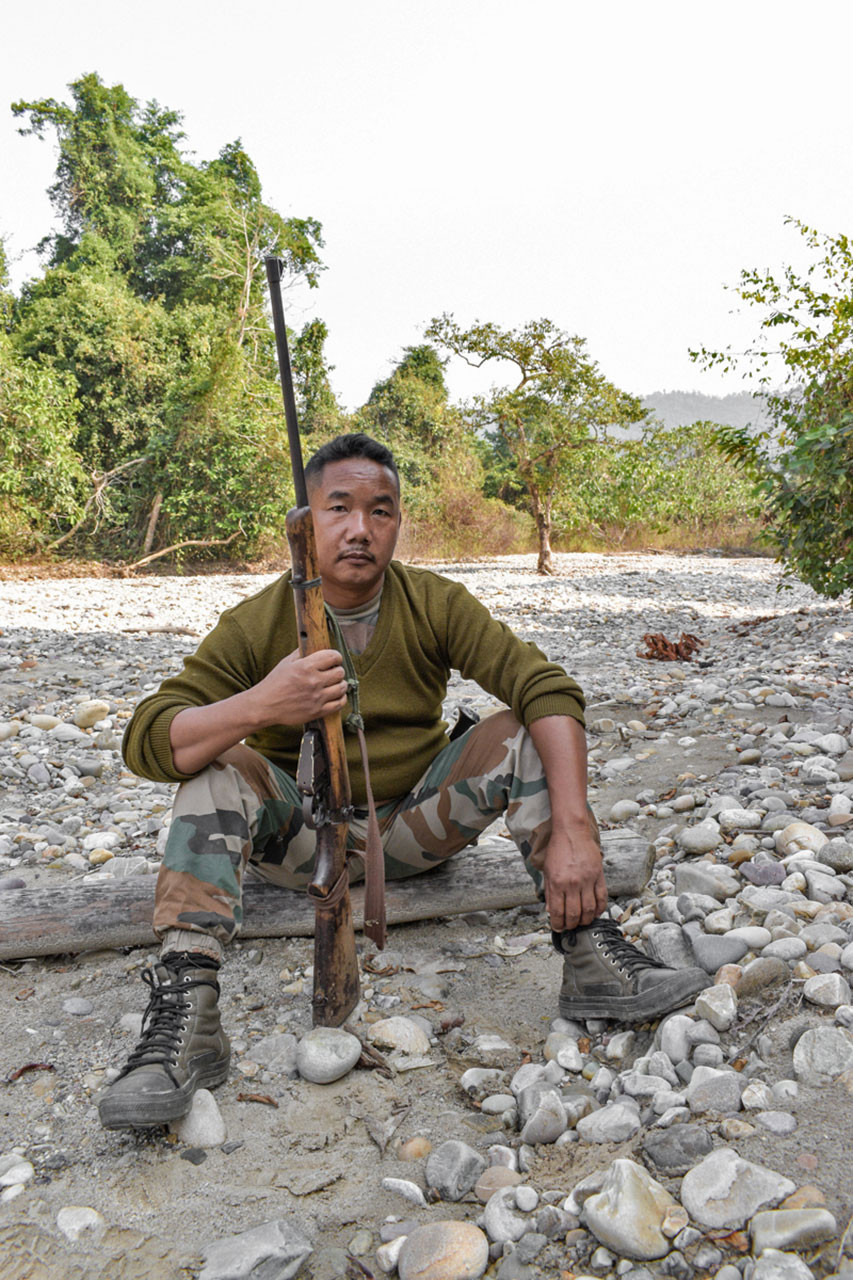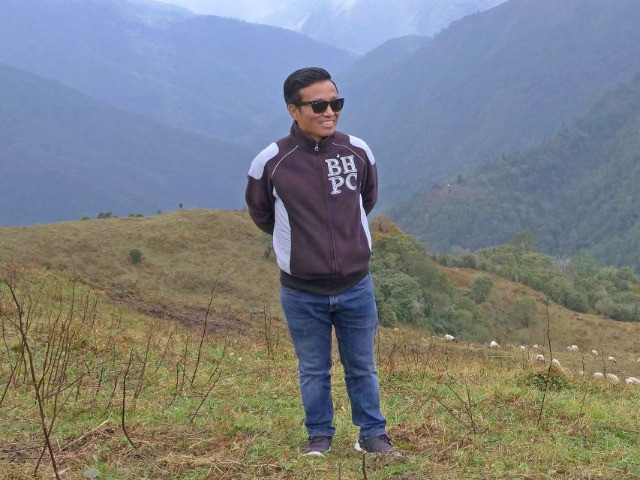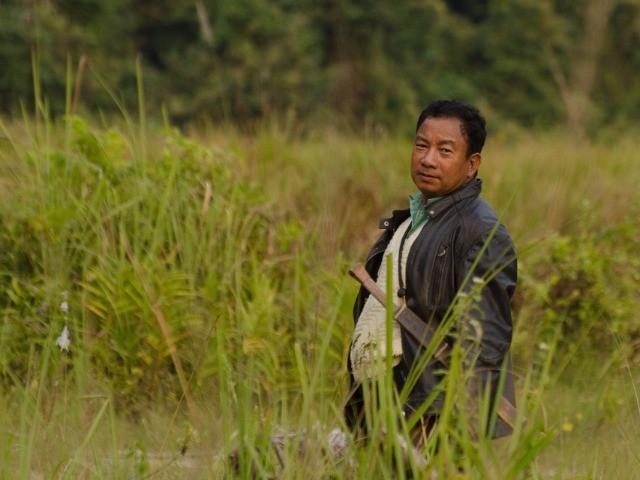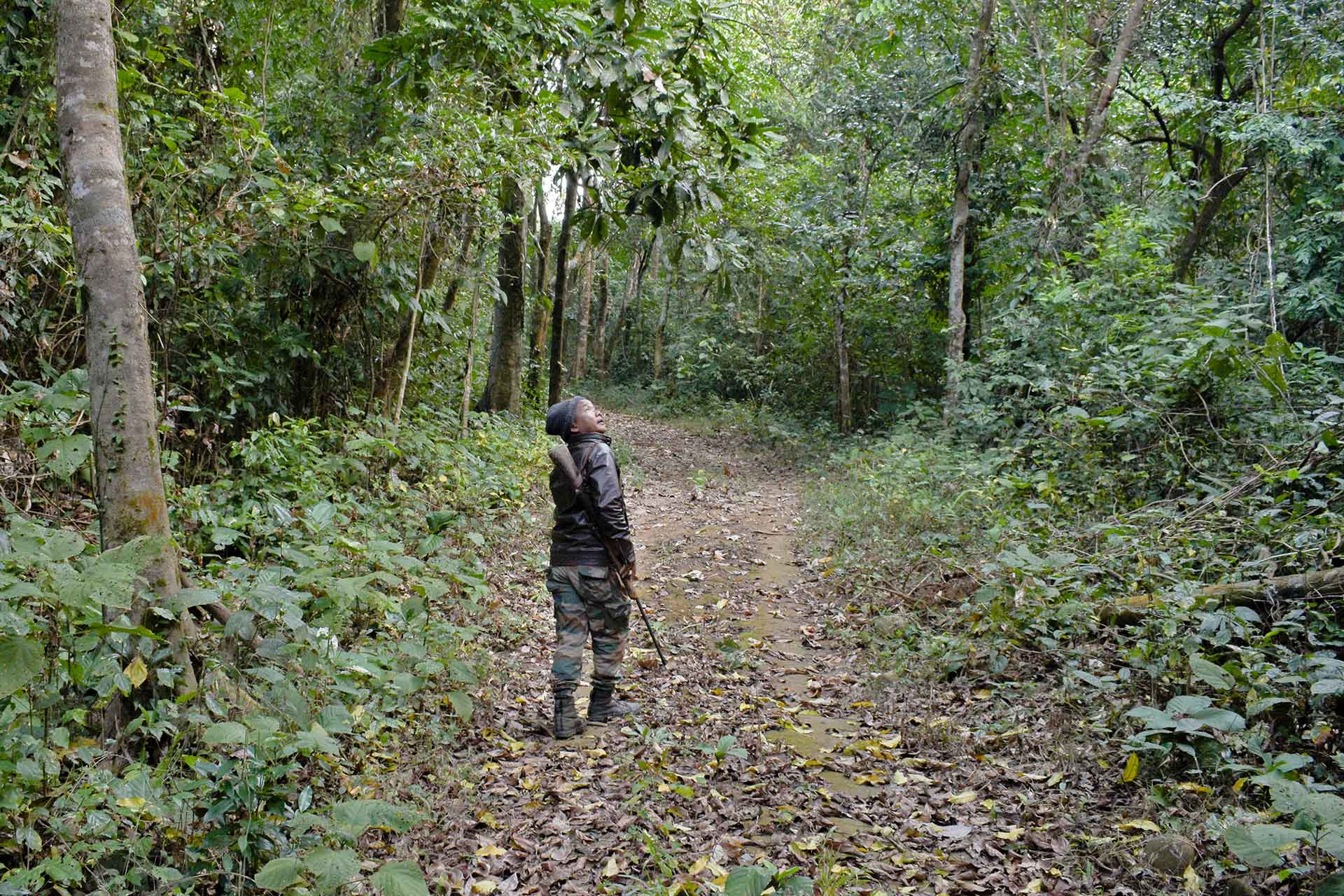The orange sun of daybreak had just presented itself at the horizon, and the damp air carried a beautiful smell of moist earth, soaked in the characteristically profuse morning dew of Northeast India's humid tropical forests. It was just another customary winter morning at Pakke Tiger Reserve, but it had me wide-eyed and curious. My senses were overwhelmed from trying to take in more than they could register. Tana Takkar, an STPF (Special Tiger Protection Force) Officer, was to accompany me through the forest while ensuring as much safety as possible. Tana ji was familiar with every pulse of the forest, from patrolling 200km on foot every month, for more than a decade. His calm nature was infectious—a steady walking rhythm set in soon, and my senses transitioned from frenzied hyperactivity to a state of calming awareness.
Spread over a vast 800sq.km. in the northeastern state of Arunachal Pradesh, Pakke Tiger Reserve is a crucial juncture between the Indo-Malaya biogeographic realms. The region falls within the global biodiversity hotspot along the Eastern Himalayan foothills. This rugged terrain that lies across an altitudinal range of 200-2040m keeps a large part of the forest inaccessible to humans and remains unexplored to date. We had entered Pakke through the West Bank Camp near Seijosa, into the iconic tropical semi-evergreen forests of the Brahmaputra valley that dominate Pakke's lower reaches. Tall simuls (Bombax sp.), bandardimas (Dysoxylum sp.) and bhelus (Tetrameles sp.) shot into the sky, emerging from amidst the dense undergrowth that flanked a narrow dirt track on both sides; an elephant could be standing amidst the tangle of vegetation, and an unsuspecting pedestrian wouldn't notice.
The hornbills, however, have their vantage—perched amidst the canopies, they see everything but are seldom keen on being seen. Even though it may be disappointing to see them fly away before you have had a good look, it is also magical to witness the forest's silence momentarily broken by the wheezing sound of their massive wings. But Tana Takkar knows how to beat hornbills at their own game. "Ready to walk off-road?” he asked with a smile after the hornbills had eluded us a few times. Tana Takkar's monthly patrols often take him deep into the tangled depths of these forests. The responsibilities of an STPF officer include meticulously documenting signs of animal presence (scats, pugmarks or carrions), alongside inferring poachers' movements from clues such as vacated camps, burnt firewood and unsprung snares on the forest floor. The pinnacle of both objectives is achieved on the occasions of direct sightings—animal sightings mostly make beautiful memories for the guards, while confrontations with poachers make nightmares.
Tana Takkar is well-versed in navigating the thickets; he shows me how to glide through the apparently impenetrable tangle of gnarling branches while sidestepping and ducking continuously. Today wasn't about finding poachers; we were only trying to be invisible to the hornbills in the canopies by walking below the undergrowth. The concealed approach took us close enough to a tall simul to watch, at leisure, a Great Hornbill, busy colouring the white feathers of its great wings yellow; the brilliant dye sourced from a pruning gland under the tail. But the episode is cut short by the sound of grunts filling the thickets around us—a herd of wild boars, invisible and in close quarters. Tana Takkar, calm and unfazed, unstraps the rifle from his shoulder and bends down, issuing instructions to follow him closely as the sidestepping and ducking through the undergrowth is resumed. We head back onto the dirt track, leaving the bush to the boars.
You may also like to read
For STPF officers like Tana Takkar, the duty of accompanying tourists around the park comes over and above the monthly mandate of 200km of foot patrol that must be completed to draw a full monthly wage of ₹22000, which seldom arrives on time. STPF guards are still employed as casual workers with the Forest Department and live with perpetual arrears of 3-4 months worth of wages.
A two-day strike in June, after six months of non-payment had only ensured a written assurance that arrears would be cleared. Dues continue to linger, and the decisions on their demand for permanency (Radhe Nabam and 42 others v/s State of Arunachal Pradesh and others, filed at the Gauhati High Court in 2019) are yet to be felt on the ground. Tana Takkar fondly remembers Pakke's legendary Divisional Forest Officer (DFO), Tana Tapi, who used to maintain a rotating fund to ensure no worker went home empty-handed on month ends even if their wages didn't officially arrive on time. Without Tapi, the dirt track we are walking on would have been a highway, going by the name East-West Corridor Road. Tana Takkar remembers how workers and researchers had enthusiastically united in protest against the project. It didn't yield much except for Tana Tapi to be transferred and researchers to get their permits banned for an entire year.
The enthusiasm, since then, has died down, now dribbling like the nalas (streams) that interrupt the forest trail at regular intervals; some of them dry, others still alive with a trickling flow of muddy water. "You should see these streams during monsoon," Tana Takkar says as he steps expertly across a nala, balancing on pebbles. I try to follow suit but soon miss my step and emerge with muddied shoes. "These turn into fast-flowing, gurgling streams, often knee-deep, during the rains. There is no way to keep your shoes dry then." As Tana Takkar speaks, a rotting log gives way under him, and his heavy boots hit the muddy water with a splash. "Looks like I can't keep them dry in winter either!" Tana Takkar laughs, sending an Oriental Pied Hornbill soaring with a wheeze.
The forests of Pakke are perpetually alive with the myriads of little birds that call it home. Scarlet Minivets fly around in groups, and the air is sweet with the songs of sunbirds. The thickets are alive with swooping Racket-tailed Drongos, and the Small Niltava shines like lapis lazuli in the shadowy groves, where rarities like the Silver-eared Mesia and Red-billed Leiothrix pay surprise visits. Amidst all this, Tana Takkar talks of home—his wife, their daughters, the rice-yielding farmland, the betel nut plantations, and the company of fellow Nyishi tribesmen. He wonders why he left all of that behind—he remembers being driven by the will to ensure his little brother's education. Soon after he left home, taking up work as a ranger in Kamlang Tiger Reserve, Tana's little brother chose to drop off from college. "If not for the hopes of a permanent job, I would have left long back", Tana tells me as both of us stand transfixed, witnessing the brilliant exuberance of life in the depths of Pakke Tiger Reserve. Tana agrees to the forest's charms but refuses to be enchanted. He knows well the lesser beautiful sides of working in the wilderness.
The landscape is altered drastically as we approach the sandbanks of Pakke river near the Khari beat office. The riverside at Khari is like a cauldron, cliffs rise sharply from the banks of the river and tall grasslands border the transition from dense woodland to the bhabar-like formations by the river (Bhabar is a region south of the Lower Himalayas and the Shivalik Hills). Wintering Siberian Stonechats abound the grasslands, and far down the river, a Muntjac crosses into the tall grass. Tana Takkar is busy looking down, scanning through the variety of pugmarks on the sandy soil. "That's a Sambar, this one is a Muntjac, those are gaurs, and I probably don't need to tell you that those are elephants", Tana ji's expert eyes continue to scan the bank until they finally stop, “...tiger!" Tana Takkar notes down some measurements, and we follow the tiger's footprints until they disappear into the tall grass. "At least a day or two old, we probably won't see it", Tana ji infers.
Khari is the furthest we are allowed. Venturing ahead towards Dikhroi requires special permissions from the DFO. "You know, it has been so long since I have had a good tiger sighting. I hear you get to see a lot of tigers in Kaziranga,'' Tana Takkar has been requesting a transfer to Kaziranga for quite some time, but with Pakke’s West Camp manned by just 56 STPF officers, it probably cannot afford to see him go. Tana Takkar sets a faster pace for our return journey. Halts are few and far between as we are required to be back at the West Camp within a stipulated time frame. As I walk behind him, not allowed to be distracted by the birds, I notice how tall the forest looks against Tana Takkar's short stature; the responsibilities and perils of his job seem taller. But with the ancient 4.5kg Lee-Enfield 0.303 Rifle slung over his shoulder, Tana ji's gait is as calm as the forest.
***
It is a gloomy morning—with the sun invisible behind the rainclouds, the dawn looks younger than it is. But so does Tana Takkar; nothing in his appearance suggests he is nearing his fifties. Today, on a forest trail hugging the eastern boundaries of Pakke, his movements are more cautious than usual—the dirt track is strewn with elephant dung at regular intervals. Coprophilous fungi have begun to sprout, suggesting that the droppings are not too recent, but Tana ji believes you can never take signs of elephant movement lightly. We trudge along in silence, past the fidgety ioras and whiskered yuhinas, until we arrive at the Sukha Nala. The dry riverbed becomes an animal highway in these winter months and Tana Takkar, like at Khari, gets busy reading the plethora of pugmarks and other signs of animal movements. The Sambars and gaurs that have walked down the riverbed, wild boars and elephants that have moved across, the cattle from surrounding villages that have strayed into the forest—nothing goes amiss.
Crossing over to the other side of Sukha Nala, the realm of forests begins again and advancing past a few more muddy nalas, we arrive at the Manjo Nala, where a clear ankle-deep flow continues to thrive even during peak winter. By the nala, on an elevated hillock and under the shade of a giant simul lies the Manjo Nala Anti-Poaching Camp. During his long tenure as DFO, Tana Tapi set up these camps along the park's border by the perennial nalas inside the forest; some like the Manjo Camp lie directly on the main forest trail, while others like the Duna and Baram Nala Camps are connected by narrow trails, that fork from the main one. At Manjo Nala, the young Tana Karchang is full of words, "Just look at what the elephant herds have done," he points to the wooden stairs that lead up to the chaang (raised housing structure of bamboo or concrete)," it has been months since they knocked down the concrete stairs. Now we have to climb up and down a temporary one that I made with bamboo. Still, they won't fix the solar[-powered electric] fence!" Here at Manjo Nala Camp, a simple metal wire decorated with colourful pieces of cloth is all that is there to deter the elephants.
Tana Karchang, like Tana Takkar, is a casual employee at the forest department and is entitled to a monthly salary of ₹11,000; for the last two months, none of that has arrived. Karchang talks of beautiful nights under the stars and how even those nights begin to feel unbearable after months of sitting in complete darkness; the battery-powered lights at the camp haven't been looked after. "The nala is down there, you see. Carrying buckets of water up here is not easy. In monsoons, I get leeches all over me every time I have to go down for water," Tana Karchang complains, assuming that me knowing of his hardships can make a difference. Tatang Tok, the older man at the camp, speaks very little. He prepares a salty tea for the four of us and after handing us our glasses, climbs up the wobbly stairs to the top of the chaang. As the strong taste of the tea disrupts the slumber that the gloomy morning had induced, young Karchang's commentary seems to be amplified by Tatang's show of apathy.
The forests around the Manjo Nala Camp look and smell very different from the parts we had walked so far. The dominant smell of petrichor is subdued by the flowers of myriad shapes and colours—brilliant reds, bright yellows, calm purples and sober whites. "It's a pity the sun isn't out today", says Tana Takkar, "otherwise you'd have seen so many butterflies here". We hoped for the sun and the butterflies to be out during our return as we tread past beheaded beetles, startling a pair of foraging Kalij Pheasants with our presence. The sun begins to show, the activity in the thickets slowly begins to peak, and Tana Takkar talks of his concerns over the recurring cycles of the pandemic, "My daughters are very sincere with their studies, you know, but the schools keeps shutting every now and then". At Balijan, a village in the Papumpare district of Arunachal Pradesh, neither the school nor the average student can afford online education and closures translate to a pause in children's education. For families like Tana ji's, education is seen as a priority; but for others, such pauses often translate to a dead end. "I just hope they are back at school by the time I am back at Balijan next," Tana Takkar has saved up ten leaves over the last two months, and his usual 15-day sojourn with family is just one more month away.
By the time stories from Tana ji's early days as a ranger at the Kamlang Tiger Reserve carried us to the Firing Nala Camp, the grey sky had transformed into a brilliant blue, and cottony white flakes had replaced the ceaseless blanket of rain clouds. A pile of elephant droppings lay right in front of the gate, but the camp looked unhurt, probably because of the perfect solar-powered electric fencing. Firing Nala Camp seemed to be in far better shape than the previous camp, with concrete stairs leading up to a neat room with beds and closets for the guards. Water supply was the main issue as the nala is a bit too far from the camp for comfort. Firing Nala Camp has to rely on water, channelised via bamboo ducts, from an underground water source up in the hills. “The wild boars and elephants regularly damage these channels, and I have to repair them almost every week," says Ramesh Tarang. He isn't complaining though, "It takes effort, but it also eats up a bit of my time. The days, otherwise, are too long for me!" Tarang, a 22-year-old Karbi youth, hails from the same village as Tana Takkar. "Here, in the forest, I always lose count of the days,” Ramesh has been ceaselessly manning the camp all by himself for the past three months. John Tana from the neighbouring Baram Nala Camp often drops by for company. Ramesh readies some rice with lentils and pickles for the four of us. A 50kg sack of rice, often half-full and adulterated with hoggin, is the only monthly ration issued to anti-poaching camps. Vegetables, lentils, and the like, must be arranged for personally.
"Only sometimes during the tiger census months do they remember about supplying vegetables,'' John Tana jokes, "rest of the time, you have to be lucky to receive a proper 50kg ration." Post lunch, while Tana Takkar and Ramesh Tarang discuss home, John and I walk around the camp, watching the fidgety redstarts and skittish leaf warblers, until Tana ji decides to get going again.
As we retrace the same route back towards the West Camp, under a bright winter sun, the forest seems different and more alive. We approach Manjo Nala, and we are greeted by the butterfly spectacle that Tana ji had mentioned. The lower reaches of tree trunks, the flowers, the forest floor and even the dusty forest trail were lined with butterflies of myriad shapes, sizes and colours. At Manjo Nala Camp, Tana Karchang, who was out watching the butterflies, waves us goodbye as we pass him by. Like the day before, Tana ji allows for minimum halts during the return journey, only stopping for the butterflies until we reach Sukha Nala. At the nala, we spot footprints of a big cat, fresh ones too! After we had crossed the Sukha Nala, sometime between dawn and before we returned in the afternoon, a leopard had made the same journey– unseen and unheard, just like our frontline guards who silently strive to safeguard India’s bountiful forests.
















